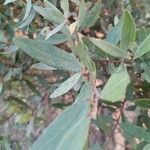Erect, dense, much branched shrubs 1-5 m high, or slender to well developed trees up to 8 m high, evergreen; trunk 5-15 cm in diam.; bark grey, smooth or old trunks rougher and darker; branches densely leafy, bark grey to brownish grey, branchlets and all young parts densely to sparsely hairy and usually covered with rust-brown granules giving them a deep rusty colour which usually later disappears, glabrescent (in the glaucous Transvaal forms glabrous when older). Leaves usually subopposite, rarely alternate, shortly petioled, glabrous, subglabrous or densely hairy on both sides, very variable in shape, broadly obovate, broadly elliptic-obovate, oblanceolate or lanceolate, 1.5-9 cm long, 0.5-3 cm wide; base cuneate to rounded; apex acute to obtuse and rounded; nerves usually raised on both surfaces, occasionally not very distinctly so on lower surface or not raised at all (Transvaal); margin usually involute, occasionally not involute, flat or undulate, entire or minutely crenulate; petiole 1.5 mm long; stipules absent. Inflorescence a pseudo-raceme, axillary, up to 2 cm long, densely to sparsely hairy and densely to sparsely covered with a rust-coloured exudate between the hairs, 3-10 flowered; male inflorescence usually longer than the female, which exceed 1 cm. Flowers dioecious, greenish-cream, cream, or white, sweetly scented, pendulous. Male flowers somewhat larger (wider) than the females, 2.5-3 mm long. Calyx saucer-shaped, about 1/3 the length of the corolla, subglabrous to fairly densely hairy, usually also with rust-coloured or blackish granules; lobes 4(5), deltoid or represented only by teeth on the rim of the calyx. Corolla campanulate to widely campanulate, hairy with appressed bristles along the middle of the lobes; tube about half the length of the corolla; lobes usually 4(5), usually obtuse, contorted. Stamens about 20, in two rows and often in pairs together; filaments glabrous up to 1 mm long; anthers 2.5 mm long, lanceolate to oblong-lanceolate, hairy. Ovary rudimentary, bristly, with two rather slender glabrous styles, or without styles. Female flowers smaller but otherwise like the males. Staminodes occasionally present, strap-shaped. Ovary ovoid, densely bristly, 4-celled (or 2-celled upwards due to incomplete septation of cells) with a single pendulous ovule in each cell; style thick, short, with crescent-shaped somewhat oblique stigmas. Fruit globose, 4-5 mm in diam., hairy, glabrescent, with a thin fleshy covering, black when ripe, one seeded. Seeds globose, 3-4 mm in diam., divided into three parts by 2 thin, curved lines and a groove; endosperm flinty, not ruminate.
More
Tree or shrub, 1-9 m high; young parts with rust-brown granules. Leaves 15-50 x 5-12 mm, opposite to subopposite, petiolate, shape varies, glabrous to densely hairy, paler beneath, margins entire or scalloped, revolute. Inflorescence a pseudo-raceme, axillary, hairy, 3-10-flowered; male inflorescence longer than female. Flowers inconspicuous, greenish to yellow or white, pendulous, sweetly scented. Flowering time Nov.-Feb. Fruit globose, hairy, reddish brown turning black. Seeds globose, 3-4 mm in diam.
A shrub. It grows 1-2 m high. It can be up to 8 m tall. The bark is grey and smooth. The leaves are sword shaped and 1.5-5 cm long by 0.5-1.5 cm wide. The colour of the green can vary but leaves are paler underneath. The flowers are very small and green to yellow. There are 3-10 flowers in sprays in the axils of leaves. The fruit is a round berry the size of a pea. It is red but becomes black when ripe. The fruit is edible. There is one seed.
Dioecious shrub or tree to 8 m, rusty granular on young parts. Leaves sometimes hairy, obovate to lanceolate. Flowers in rusty granular, axillary racemes, hairy, deeply cleft, cream-coloured, fragrant, ovary bristly.


